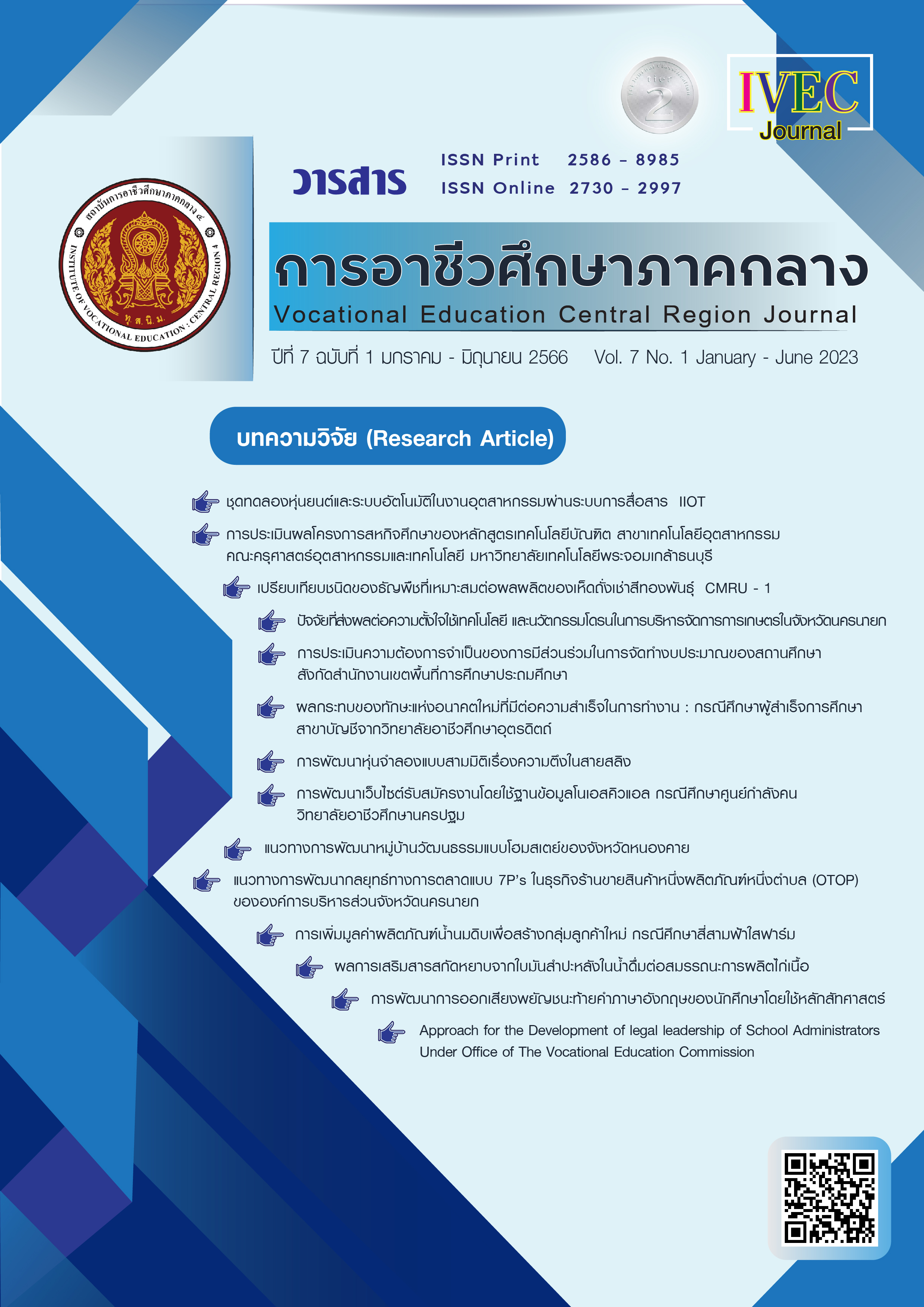Effect of Supplementation of Cassava Crude Extract in Drinking Water on Productive Performances of Broiler
Main Article Content
Abstract
The use of herbs in economic animal husbandry is one way to reduce the use of antibiotics. Cassava leaves contain high amounts of tannins. With active ingredients to inhibit the growth of bacteria and disinfection that causes diarrhea Therefore, the purpose of this study was to determine the effects of supplementation of cassava crude extract in drinking water on broiler production performance. A total of 80 one -- day - old arbor - acre broiler mixes were randomly divided into 4 groups of 4 reps of 5 each, based on completely randomized design. The treatment consisted of (i) Drinking water mixed with antibiotic Oxytetracycline 0.3 mg/l. (ii), (iii) and (iv) Drink with tannin extract at levels 10, 20 and 30 mg/l, respectively. 42 day trial. The resultst showed that the broilers in the treatments at and 4 had adequate feed intake. 3,666.25, 3,671.25, 3,697.50 and 3,692.50 g/head (P>0.05) body weight gain 1,970.25, 1,985.50, 1,980.13 and 1,930.28 g/head (P < 0.05), growth rates 46.91, 47.27, 47.14 and 45.96 g/body/day (P < 0.05) , feed conversion ratio 1.86, 1.84, 1.86 and 1.91 (P < 0.05), The survival rates were 100, 95, 100 and 95 percent (P>0.05) and food cost per kilogram body weight gain 32.56, 32.36, 32.68 and 33.74 baht (P<0.01). It can be concluded that supplementation with cassava leaves crude extract in drinking water at the level of 10-20 mg/l had a positive effect on growth performance.
Article Details

This work is licensed under a Creative Commons Attribution-NonCommercial-NoDerivatives 4.0 International License.
|
บทความ ข้อมูล เนื้อหา รูปภาพ ฯลฯ ที่ได้รับการตีพิมพ์ในวารสาร การอาชีวศึกษาภาคกลาง ถือเป็นลิขสิทธิ์ของวารสารการอาชีวศึกษาภาคกลางหากบุคคลหรือหน่วยงานใดต้องการนำทั้งหมดหรือส่วนใดส่วนหนึ่ง ไปเผยแพร่ต่อหรือเพื่อกระทำการใด ๆ กองบรรณาธิการไม่สงวนสิทธิ์ ในการคัดลอกบทความเพื่อการศึกษาแต่ให้อ้างอิงแหล่งที่มาให้ครบถ้วน สมบูรณ์ สงวนสิทธิ์ โดย สถาบันการอาชีวศึกษาภาคกลาง 4 ที่ตั้ง 90 ถนนเทศา ตำบลพระปฐมเจดีย์ อำเภอเมือง จังหวัดนครปฐม โทรศัพท์ 034 242 856 , โทรสาร 034 242 858 ISSN : 3056-9176 (print) ISSN : 2985-2382 (online) |
References
ดุจดาว คนยัง, ณัฐพร จันทร์ฉาย, และ วิวัฒน์ หาญธงชัย. (2553). การใช้สมุนไพรไทยในการเพิ่มสมรรถภาพการเจริญเติบโต และควบคุมโรคบิดในไก่เนื้อ. รายงานผลการวิจัย มหาวิทยาลัยแม่โจ้ เชียงใหม่ : มหาวิทยาลัยแม่โจ้
บุญนำพา ด่างเหลา และ ไพฑูรย์ ศรีโพนทัน. (2562). ผลของสารโพลีฟีนอลที่สกัดจากเปลือกเมล็ดมะขามต่อสมรรถนะการผลิตไก่เนื้อ. ในการประชุมวิชาการระดับชาติ สอฉ 3 วิจัยและนวัตกรรม ครั้งที่ 2 (6 กันยายนหน้า 125). มหาสารคาม : โรงแรมเอส - ตะวัน.
ไพฑูรย์ ศรีโพนทัน. (2550). ผลของกล้วยน้ำว้าดิบบดต่อการรักษาโรคท้องร่วงในลูกสุกร. เอกสารประกอบในการประชุมวิชาการเครือข่ายการวิจัยสำนักงานคณะกรรมการวิจัยแห่งชาติ ร่วมกับมหาวิทยาลัยมหาสารคาม. มหาสารคาม : มหาวิทยาลัยมหาสารคาม.
ไพฑูรย์ ศรีโพนทัน, บุญนำพา ด่างเหลา, และ ธนพนธ์ ธิสงค์. (2566). ผลการเสริมใบมะเขือพวงผงในอาหารต่อสมรรถภาพการผลิตและระดับคอเลสเตอรอลในเลือดของไก่เนื้อใน.การประชุมวิชาการระดับชาติสถาบันการอาชีวศึกษาเกษตร ครั้งที่ 5 ในหัวข้อ “BCG Model for Agriculture” (1 มีนาคม). ยโสธร : วิทยาลัยเกษตรและเทคโนโลยียโสธร.
เมธา วรรณพัฒน์ และ กฤตพล สมมาตย์. (2545). ผลของแทนนินที่ได้จากใบมันสำปะหลังต่อการย่อยได้ของโปรตีนหยาบ และกรดแอมมิโนที่สำคัญในส่วนรูเมนและลำไส้. ขอนแก่น : มหาวิทยาลัยขอนแก่น.
รัตนา อินทรานุปกรณ์. (2547). การตรวจสอบและการสกัดแยกสารสำคัญจากสมุนไพร. กรุงเทพฯ : สำนักพิมพ์แห่งจุฬาลงกรณ์มหาวิทยาลัย.
ศิริวรรณ แก้วเพ็ชร์, สุณีนุช คุ้มภัย, สุรัตน์ โหนา, และ อลิษา โต๊ะ. (2553). การศึกษาสารสกัดแทนนินจากพืชในการยับยั้งการเจริญเติบโตของเชื้อแบคทีเรีย. ปทุมธานี : มหาวิทยาลัยเทคโนโลยีราชมงคลธัญบุรี.
สาธร พรตระกูลพิพัฒน์, พิทัย กาญบุตร, ประสาทพร บริสุทธิเพ็ชร, กิ่งกาญจน์ สาระชู, เจษฎา จิวากานนท์, ฉันทนา อารมณ์ดี และโสพิศ วงศ์คำ. (2547). ผลของสารสกัดด้วยน้ำและแอลกอฮอร์ของผลกล้วยน้ำว้าดิบใบข่อย และเปลือกข่อยต่อเชื้อ Escherichia coli (F 18+). ในการประชุมสัมมนาวิชาการเกษตรแห่งชาติประจำปี 2547 “ศุภสัตว์ไทย อาหารมาตรฐานโลก” (26 - 27 มกราคม หน้า 357-361). ขอนแก่น : ห้องประชุมกวี จุติกุล คณะเกษตรศาสตร์ มหาวิทยาลัยขอนแก่น.
สำนักงานเศรษฐกิจการเกษตร. (2564). สถานการณ์การส่งออกไก่เนื้อของไทย. สืบค้นวันที่ 22 พฤศจิกายน 2564. จาก https://bit.ly/3LUt4ru
อังสุมา แก้วคต. (2563). การใช้สมุนไพรเพื่อลดการใช้ยาปฏิชีวนะในอาหารสัตว์และการตกค้างในเนื้อสัตว์. ค้นเมื่อ พฤศจิกายน 2, 2564, จาก http://scimooc.bsru.ac.th/index.php?type=&page=4
เอกสิทธิ์ สมคุณา, กิตติศักดิ์ แท่นแก้ว, วิรัตน์ และโสภา, บุญเพ็ง แก้วคูณ, และกนกพร โยธิน. (2566). ผลการใช้ใบบัวบกในอาหารต่อสมรรถภาพการผลิตของไก่กระทง. ในการประชุมวิชาการระดับชาติ สถาบันการอาชีวศึกษาเกษตร ครั้งที่ 5 ในหัวข้อ “BCG Model for Agriculture” (1 มีนาคม). ยโสธร : วิทยาลัยเกษตรและเทคโนโลยียโสธร.
Khang, D.N., & Wiktorsson, H. (2006). Performance of rowing heifers fedurea treated fresh rice straw supplemented with fresh, ensiled or pellected cassava foliage. Livestock science Journal. 102, (1), pp. 132 - 139.
Leite, L., & Dourado, L., (2013). “Laboratory activities, science education and problem - solveing skills”. Procedia - Social and Behaviral Sciences, 106, (10), pp. 1677 - 1686.
Netpana, N., Wanapat, W., Poungchompu, O., & Toburan, W. (2001). Effect of con densed tannins in cassava hay on faeca l parasitic egg counts in swamp buffaloes and cattle. In Intemational workshop on curentresearch and developmentonuse of cassava as animal feed.preston T.R ., ogle (23 - 24 July pp. 41 - 44). Khonkaen : khonkaenuniversity


